Sheratan, designated as Beta Arietis, is the second-brightest star in the zodiacal constellation of Aries, the celestial ram. The star mark’s the ram’s second horn.
Key Facts & Summary
- Sheratan is also designated as 6 Arietis. It is located at around 59.6 light-years / 18.3 parsecs away from our Solar System.
- This star has an apparent magnitude of 2.655, and an absolute magnitude of 1.55.
- Sheratan is an A-type main-sequence star of spectral type A5 V.
- It has around 2.34 solar masses, and it is 23 times brighter than our Sun.
- Sheratan is also hotter than our Sun, having surface average temperatures of around 9,000 K.
- This star’s surface gravity has been measured at around 4.0 cgs.
- Sheratan is a fast-spinning star, having a rotational velocity of 73 km / 45.3 mi per second.
- The radial velocity is at -1.9 km / -1.1 mi per second.
- Sheratan also has a companion star that is four magnitudes fainter. It has a stellar classification of either F5 III-V or G0 V.
- The secondary star is 30% brighter than our Sun and has around 1.34 solar masses.
- The two stars complete their highly elliptical orbit once every 107 days.
- Sheratan is around 300 million years old, it is much younger than our Sun.
- Sheratan is the second-brightest star in Aries, after Hamal.
- This star, along with its neighbor, Mesarthim, marks one of the celestial Ram’s horns.
- These two stars were important in antiquity due to their proximity to the northern spring equinox, also known as the First Point of Aries.
- The constellation of Aries is the 39th largest constellation in the sky, stretching for around 441 square degrees. The best time to observe Sheratan, or the other bright stars and deep-sky object in Aries, is during the month of December.
β Arietis
Beta Arietis is known by the traditional name Sheratan. Its name comes from the Arabic Al Sharatan – meaning the “two signs” – a reference to the star having marked the northern vernal equinox together with Gamma Arietis several thousand years ago.
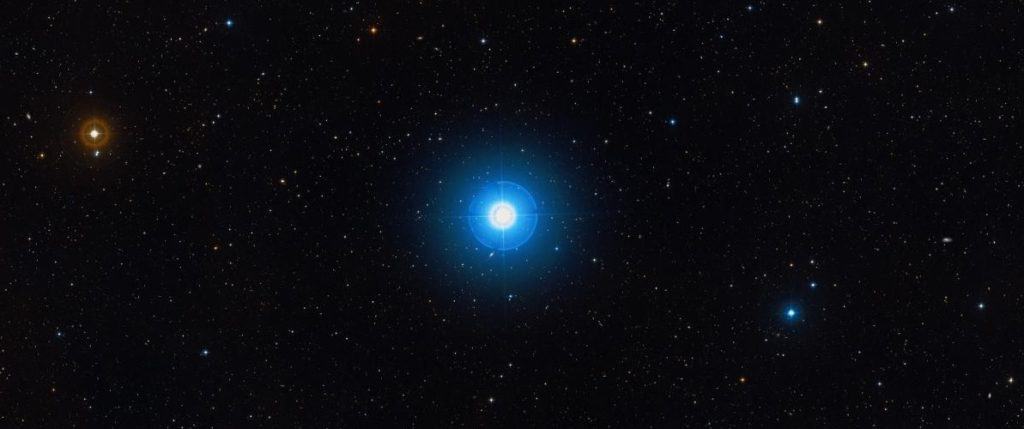
The name, Sheratan, was approved by the IAU in 2016, to be the traditional name of the second-brightest star in Aries, Beta Arietis.
Formation
Sheratan formed around 300 million years ago from a rich interstellar medium of gas and dust, such as a molecular cloud. Gravity pulled the swirling gas and dust together, and when the right temperature was reached, the second-brightest star in the zodiacal constellation of Aries, the celestial ram, Sheratan / Beta Arietis, was born.
It is uncertain if its fainter companion, designated as B, formed out of the same interstellar medium as Sheratan.
Distance, Size, and Mass
Sheratan is located at around 59.6 light-years / 18.3 parsecs away from our Solar System. It is bright enough to be visible to the naked eye.

Sheratan has around 2.34 solar masses or 234% of our Sun’s mass, and its radius remains unknown. Its companion, Sheratan B, has around 1.34 solar masses, or 134% of our Sun’s mass, and its radius is also currently unknown.
Other Characteristics
Sheratan is an A-type main-sequence star of spectral type A5 V. It has an apparent magnitude of 2.655 and an absolute magnitude of 1.55. Sheratan is 23 times brighter than our Sun.
The surface gravity on this star has been recorded at 4.0 cgs. Sheratan is hotter than our Sun, having temperatures of around 9,000 K, or 1.5 times hotter than our Sun.
This star is still fusing hydrogen to helium at its core, and it may be a mild metallic-line star, with strong absorption lines of metals such as zinc, strontium, barium, and others.
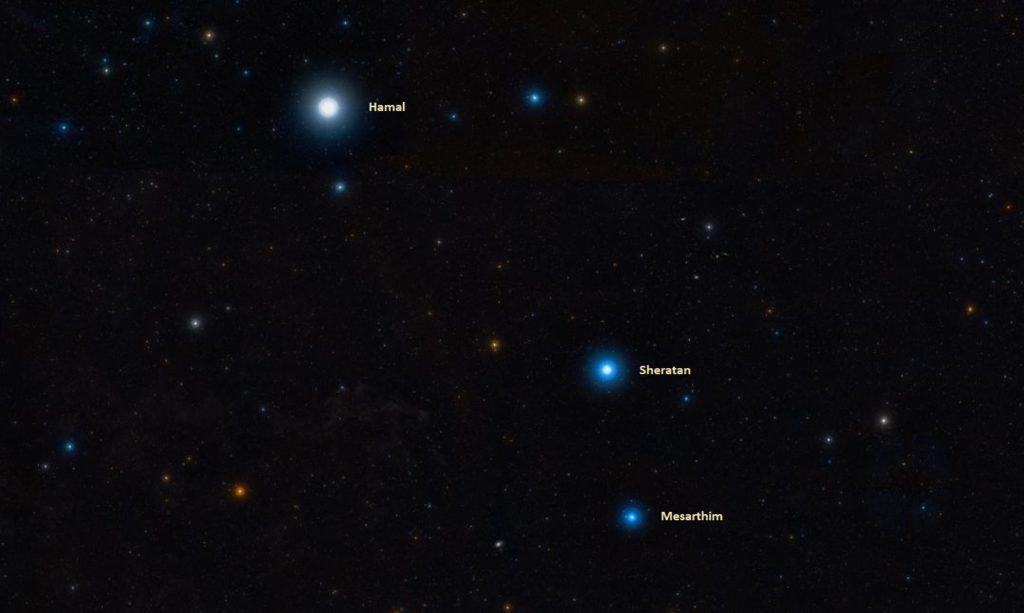
It has deficiencies of other elements on the other hand, such as calcium, or scandium. It has narrow hydrogen and ionized calcium lines in its spectrum.
Sheratan is also a fast-spinning star, having a rotational velocity of 73 km / 45.3 mi per second, while its radial velocity is at -1.9 km / -1.1 mi per second. Since it spins so fast, the star may be enveloped by a circumstellar disk of dust and gas.
Star System
Sheratan / Beta Arietis is a spectroscopic binary system, which consists of two stars locked in a tight, highly elliptical orbit, which is completed once every 106 days or so.
The two stars are separated by just 0.64 AU, and when they orbit one another, they come within 0.08 AU, and then they drift apart, as far as 1.2 AU.

The companion star is 4 magnitudes fainter than the primary star, Sheratan. Since it is difficult to observe, the companion star’s spectral classification hasn’t yet been determined. Some theorize that it could be a star of stellar classification type F5 III-V, or G0 V.
Location
Sheratan / Beta Arietis is located in the zodiacal constellation of Aries, the celestial ram. It is the second-brightest star in the constellation after Hamal / Alpha Arietis.
Sheratan is easy to locate since it forms a distinctive triangle pattern with Hamal and Mesarthim. They are located in an area of the sky between the bright Pleiades cluster (Messier 45), and the Great Square of Pegasus asterism.
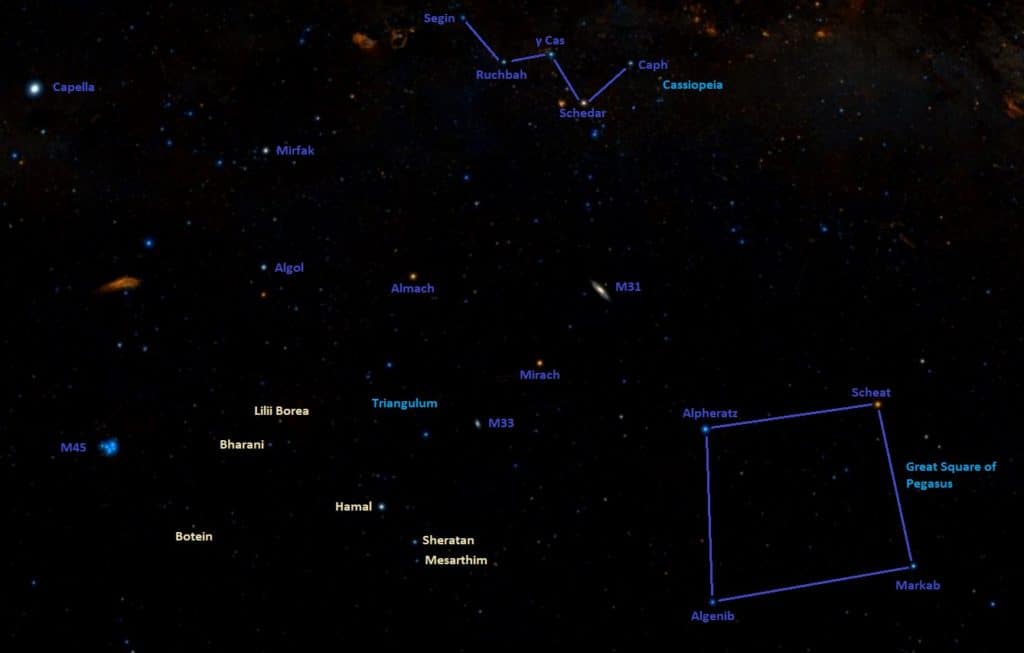
These three Aries stars lie just under the elongated triangle asterism which gives the Triangulum constellation its name, which is formed by Mothallah, Beta, and Gamma Trianguli stars.
Sheratan also mark’s the celestial ram’s second horn, along with Mesarthim. Sheratan also lies in the vicinity of the NGC 691 Group of Galaxies, after the intermediate spiral galaxy NGC 697.
The zodiacal constellation of Aries is among the first 48 Greek constellations, listed by the famous astronomer, Ptolemy, in his 2nd century Almagest.
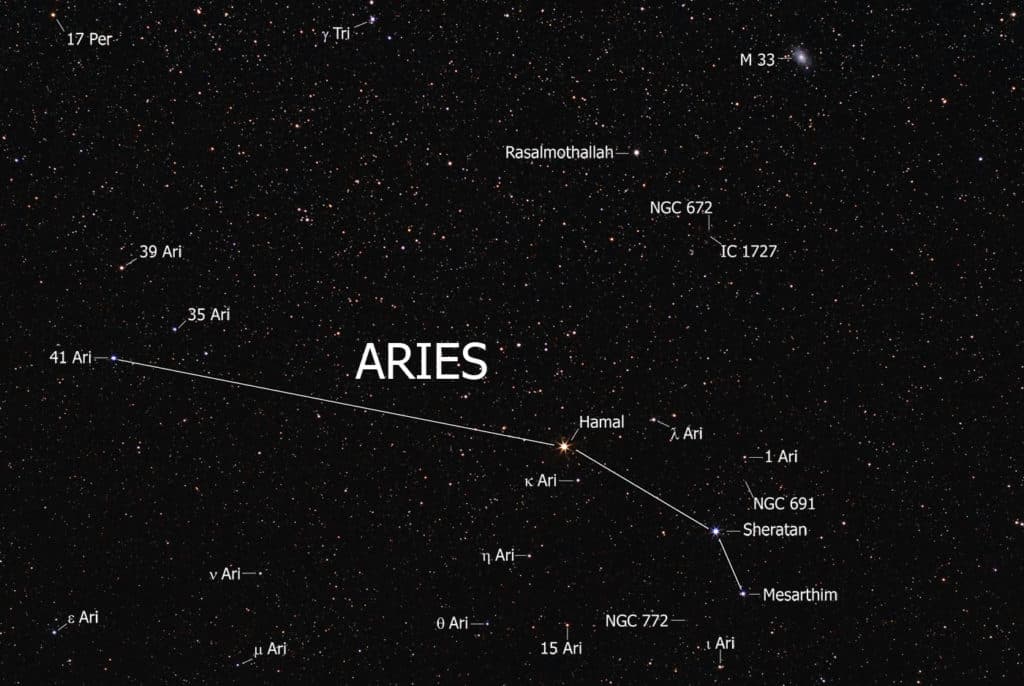
Aries is now among the 88 modern constellations, where it holds the title of the 39th largest constellation in the sky since it stretches for over 441 square degrees.
Aries is located in the northern sky between the constellations of Perseus, Triangulum, Taurus, and Pisces. It is best seen from northern latitudes in the autumn and winter months.
The zodiacal constellation of Aries contains many interesting stars and deep-sky objects. Besides the aforementioned NGC 772 and NGC 691 Group of galaxies, Aries also hosts the elliptical galaxies NGC 770, and NGC 821, the colliding pair of galaxies NGC 935 and IC 1801, or the dwarf irregular galaxy NGC 1156, among many others.
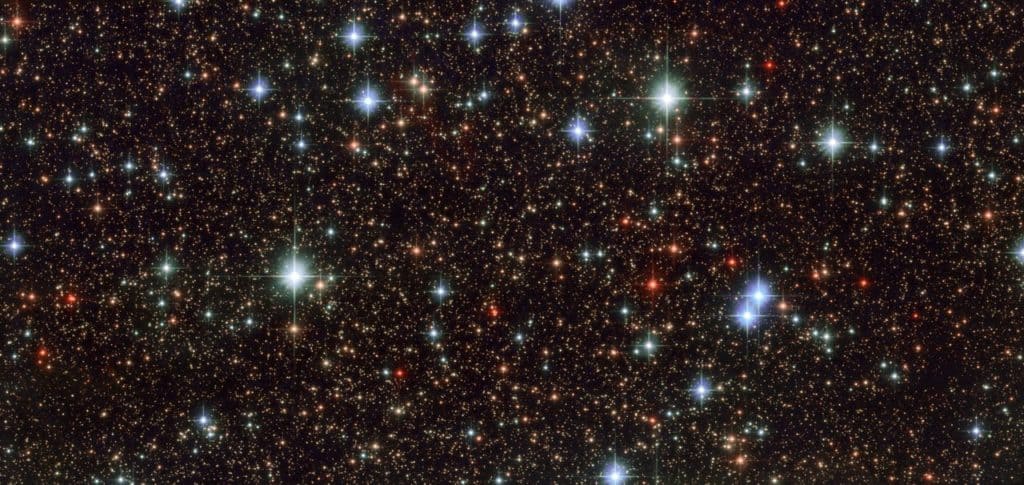
The top 10 brightest stars in the constellation of Aries ar Hamal / Alpha Arietis, at magnitude 2.00, Sheratan / Beta Arietis, at magnitude 2.6, Mesarthim / Gamma Arietis at magnitude 3.86, Botein / Delta Arietis, at magnitude 4.3, HD 20644, at magnitude 4.4, Lilii Borea, at magnitude 4.5, 35 Arietis, at magnitude 4.6, Lambda Arietis, at magnitude 4.79, and Zeta Arietis, at magnitude 4.89.
The best time to observe Sheratan / Beta Arietis, the other bright stars, and the deep-sky objects of Aries, is during the month of December, when the constellation is most prominent.
The Future
Sheratan is not massive enough to explode as a supernova, and thus, its ultimate fate is that of evolving into a white dwarf star. Before this will happen, Sheratan / Beta Arieti will become in a few million years a red giant star, and when it will reach this stage, it will transfer a vast amount of its mass to its companion, making the secondary star the more massive component of the Beta Arietis star system.
Did you know?
- The Chinese know Sheratan as Lou Su yi – the First Star of Bond. The Chinese Bond asterism is formed by Sheratan, Hamal, and Mesarthim. It marks the body of the white tiger.
- In Hindu astronomy, Sheratan and Mesarthim were known as Ashvins, the twin Vedic gods of medicine.
- The Bedouin people knew Sheratan and Mesarthim as “qarna al-hamal” – meaning “horns of the ram”.
- Both Sheratan and Mesarthim were once regarded as the heralds of the northern vernal equinox, the point where the Sun’s apparent path crosses the celestial equator from south to north, marking the beginning of spring.
- Between 2000 and 100 BCE, the equinox was located in the constellation of Aries, however, it has since moved to the constellation of Pisces, due to Earth’s axial precession.
- In 130 BCE, when the Greek astronomer Hipparchus defined this point, also known as the First Point of Aries, it was located between Mesarthim and the zodiacal constellation of Pisces. The March equinox is considered to be the “prime meridian”, used to calculate the right ascension for celestial objects.
Sources:
Image sources:
- https://www.star-facts.com/wp-content/uploads/2020/02/Sheratan.jpg?189db0&189db0
- https://www.constellationsofwords.com/images/stars/sheratan.JPG
- https://www.star-facts.com/wp-content/uploads/2020/02/Hamal-Sheratan-and-Mesarthim.jpg?189db0&189db0
- https://i.pinimg.com/originals/f8/d5/d4/f8d5d47886fc58d1d6bbd01fe9396b80.png
- https://www.star-facts.com/wp-content/uploads/2020/02/Sheratan-location.jpg?189db0&189db0
- https://www.universetoday.com/wp-content/uploads/2008/10/Aries_DSO.jpg
- https://www.iau.org/static/archives/images/screen/potw1624a.jpg
